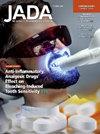2台口腔内扫描仪和一台桌面扫描仪对不同解剖结构的可摘全口义齿复制的评价
IF 3.5
2区 医学
Q1 DENTISTRY, ORAL SURGERY & MEDICINE
引用次数: 0
摘要
技术的进步使口腔内扫描仪(ios)能够复制可移动全口义齿(rcd)。作者评估了扫描仪对RCD复制的采集有效性和准确性,以及人工地标对上颌(mx) RCD采集成功的影响。方法2台ios4 (Primescan, Dentsply Sirona和TRIOS 4, 3Shape A/S)和1台桌面扫描仪(DS) (D2000, 3Shape A/S)分别扫描10个mx和10个下颌rcd。用人工标记物重新扫描Mx rcd。利用Geomagic软件(3D Systems)将获取的文件与参考的虚拟RCD设计文件进行比较。客观测量包括获取效果,目测和统计评估(Pearson χ2检验);准确性,通过真实度(平均接近度)评估;精密度(可重复性)(单变量方差分析和Student-Newman-Keuls检验,α = 0.05);使用容限阈值和比色偏差图评估临床准确性。结果只有DS成功复制了所有的rcd。ios未能获得一些mx rcd (Primescan, 50%; TRIOS 4, 10%),使用地标没有实质性改善。DS的准确率最高(mean [SD], 28 [22] μm; P < 0.05)。Primescan和TRIOS 4具有相似的准确率(平均[SD]分别为59 [25]μm和60 [25]μm)。DS和Primescan的精度(平均[SD],分别为72 [36]μm和70 [20]μm)优于TRIOS 4(平均[SD], 104 [29] μm) (P < 0.05)。结论DS是复制rcd最可靠的方法。RCD特征影响IOS用户获取成功。实际意义数字RCD扫描可以提高临床工作流程。获得下颌RCD比获得mx RCD更可行。优化技术和确定促进获取的因素对临床可行性至关重要。本文章由计算机程序翻译,如有差异,请以英文原文为准。
Evaluation of 2 intraoral scanners and a desktop scanner for replicating removable complete dentures of various anatomies
Background
Technological advances have enabled intraoral scanners (IOSs) to replicate removable complete dentures (RCDs). The authors evaluated the acquisition effectiveness and accuracy of scanners for RCD replication and the impact of artificial landmarks on acquisition success for maxillary (mx) RCDs.
Methods
Two IOSs (Primescan, Dentsply Sirona and TRIOS 4, 3Shape A/S) and 1 desktop scanner (DS) (D2000, 3Shape A/S) scanned 10 mx and 10 mandibular RCDs. Mx RCDs were rescanned with IOSs using artificial landmarks. Acquired files were compared with the reference, the virtual RCD design file using Geomagic software (3D Systems). Objective measurements included acquisition effectiveness, assessed visually and statistically (Pearson χ2 test); accuracy, evaluated through trueness (average closeness); and precision (repeatability) (univariate analysis of variance and Student-Newman-Keuls test, α = .05); and clinical accuracy, assessed using tolerance thresholds and colorimetric deviation maps.
Results
Only the DS successfully replicated all RCDs. The IOSs failed to acquire some mx RCDs (Primescan, 50%; TRIOS 4, 10%) with no substantial improvement using landmarks. The DS had the highest trueness (mean [SD], 28 [22] μm; P < .05). Primescan and TRIOS 4 had similar trueness (mean [SD], 59 [19] μm and 60 [25] μm, respectively). The DS and Primescan had superior precision (mean [SD], 72 [36] μm and 70 [20] μm, respectively) than TRIOS 4 (mean [SD], 104 [29] μm) (P < .05).
Conclusions
The DS is the most reliable for replicating RCDs. RCD characteristics influenced IOS acquisition success.
Practical Implications
Digital RCD scanning may enhance clinical workflows. Acquiring the mandibular RCD is more feasible than acquiring the mx RCD. Optimizing techniques and identifying factors facilitating acquisition are essential for clinical viability.
求助全文
通过发布文献求助,成功后即可免费获取论文全文。
去求助
来源期刊

Journal of the American Dental Association
医学-牙科与口腔外科
CiteScore
5.30
自引率
10.30%
发文量
221
审稿时长
34 days
期刊介绍:
There is not a single source or solution to help dentists in their quest for lifelong learning, improving dental practice, and dental well-being. JADA+, along with The Journal of the American Dental Association, is striving to do just that, bringing together practical content covering dentistry topics and procedures to help dentists—both general dentists and specialists—provide better patient care and improve oral health and well-being. This is a work in progress; as we add more content, covering more topics of interest, it will continue to expand, becoming an ever-more essential source of oral health knowledge.
 求助内容:
求助内容: 应助结果提醒方式:
应助结果提醒方式:


